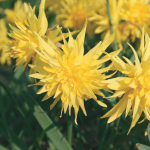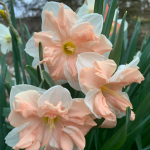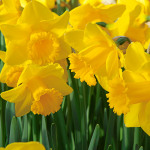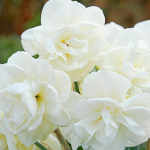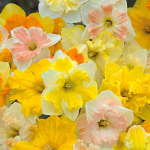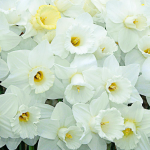Product Details
If five months of effortless bloom appeals to you, we suggest our Daffodils & Daylilies Collaboration for Sun. It includes 100 bulbs of The Works Daffodils for the North, plus 25 plants of the Crescendo Daylily (Hemerocallis) Collection. Your top-size Daffodil bulbs and bareroot Daylilies will be shipped together for your convenience in the fall. One collection covers about 75 sq ft.
The Works is a mixture of 30 top-quality varieties blended to provide the widest possible range of color, form, and bloom time. Among the assortment are colorful Trumpets, hardy Large-cups, ruffled Split-cups, as well as dainty and fragrant Tazettas and Cyclamineus varieties. Planted at the edge of a woodland or along a path, The Works is ideal for naturalizing. In smaller yards, the bulbs can be sprinkled throughout garden beds and planted alongside the mailbox and front door. They settle in quickly, bloom beautifully their first year, and then increase their numbers in the kind of sunny, well-drained site they like. This mix provides a permanent display that is immune to pests and the weather, and will never be touched by deer. Best of all, these large bulbs are easy to grow and require little maintenance. The Works is our best-selling Daffodil collection, with dozens of glowing reviews from customers who keep coming back for more.
The vigorous selections in our Crescendo Daylily (Hemerocallis) Collection provide the longest possible season of bloom in superb shades of red, orange, yellow, gold, peach, and lavender. Planted in your garden, they will catch hold quickly and shade out any weeds bold enough to appear. More important, they will provide 3 full months of glorious colors with absolutely no effort on your part. Covers about 75 sq. ft. Collection of 25 large, 2-year-old bareroot plants; 25 different varieties, not labeled..
Shipping
HOW PLANTS ARE SHIPPED
The size of the plants we ship has been selected to reduce the shock of transplanting. For some, this means a large, bareroot crown. Others cannot travel bareroot or transplant best if grown in containers. We ship these perennials and annuals in 1 pint pots, except as noted. We must point out that many perennials will not bloom the first year after planting, but will the following year, amply rewarding your patience. We ship bulbs as dormant, bare bulbs, sometimes with some wood shavings or moss. Shrubs, Roses, vines, and other woody plants may be shipped bareroot or in pots. The size of the pot is noted in the quick facts for each item.
WHEN WE SHIP
We ship our bulbs and plants at the right time for planting in your area, except as noted, with orders dispatched on a first-come, first-served basis by climate zone. We also ship a wide range of containers and planters, tools, supplies, fertilizers, garden wear, garden decor items, as well as indoor decorations like wreaths and dried bouquets when available. Estimated dates for shipping are indicated in the green Shipping Details box for each item. Please supply a street address for delivery. Kindly contact us with two weeks notice, if you'll be away at the expected time of delivery.
OUR GUARANTEE
We guarantee to ship plants that are in prime condition for growing. If your order is damaged or fails to meet your expectations, we will cheerfully replace or refund it. Please contact our Customer Service Department at 1-800-503-9624 or email us at [email protected]. Please include your order number or customer number when contacting us.
Reviews
Average Customer Rating:
 (5 Reviews)
Write a Review
(5 Reviews)
Write a Review
Sort by:
Wow!!! 
A viewer from Western NY
3 of 3 people found this review helpful. Do you? yes no Certified buyer
Fifteen Years and Going and Growing 
OnebirdieMa from NoVA
No effort for lots of color 
Shelley from Gorham, ME
I plant this wherever I move. 
Amy from New Hampshire
The combo frustrates the deer 
Kathy in Michigan from Lakeville, Michigan
Growing guide
Our Daffodils & Daylilies Collaboration combines Daffodils (Narcissus) and Daylilies (Hemerocallis) in close quarters to create a garden with two seasons of bloom—the first in spring, the second in summer. In full sun or partial shade and well-drained soil, these long-lived perennials require little care. You can count on years of enjoyment.
Planting. Prepare the planting area by loosening the soil with a shovel, spade, or tiller. Check the soil’s drainage and correct if necessary. (To improve drainage in heavy soil, dig in organic matter such as compost, aged manure, leafmold, peat moss, or [in the South] shredded pine park. If you garden in very heavy clay, consider constructing raised beds to provide well-drained conditions.) Then set the Daylilies on top of the soil, allowing 18–24in of space between each plant. For a full, natural look, arrange the plants in staggered rows. When you’re satisfied with their placement, dig a hole wide enough to accommodate the spread of the Daylilies’ roots and deep enough to allow you to set the crown (the point where the stems of the Daylilies meet the roots) 1in below soil level. Arrange the roots like the spokes of a wheel and cover them with soil, firming the soil to make sure there are no air pockets.
Next, put the Daffodil bulbs on top of the soil. Distribute them evenly among the Daylilies, allowing about 6in between the bulbs and the Daylilies. Then plant the Daffodils with a trowel or a bulb planter, setting the tops of the Daffodil bulbs 5–7in deep. Water the Daffodils and Daylilies thoroughly once the planting is finished.
In Zone 6 (-10°F) and colder, Daylilies may require winter protection (see below) to prevent the roots from being heaved out of the ground during their first winter. Next spring (late April here in Litchfield), the Daffodils will bloom while the Daylilies are still awakening from dormancy. The emerging Daylily foliage will help hide Daffodil foliage as it yellows and withers in late spring. Then, the Daylilies mount their summer show. This succession of bloom will repeat itself year after year.
Caring for the plants. We recommend applying a balanced fertilizer, such as 10-10-10, just as new foliage begins to push through the soil each spring. For the sake of tidiness, cut away Daffodil foliage after it yellows and withers (not before) and remove the spent blooms of Daylilies. After hard frost in fall, cut off Daylily leaves close to the ground.
Winter protection. In cold-winter climates (Zone 6 [−10°F] and colder), alternate thawing and freezing of the soil in winter can heave the crowns of newly planted perennials and small shrubs right out of the ground, leaving their roots vulnerable to drying winds and freezing cold. To protect plants from heaving during their first winter, put a 4–6in layer of loose organic material such as straw, oak leaves, or evergreen boughs (cut into 1–2ft lengths) over the crowns after the ground freezes (generally in December here in Litchfield, Connecticut). Take care to avoid covering the evergreen foliage of plants such as Digitalis and Dianthus.
Remove this winter cover gradually in spring when frosts become infrequent. For most perennials, this is done at about the time Daffodils and Forsythias are in bloom. However, Hemerocallis are early to emerge, and you don't want to damage the Daffodils by removing evergreen boughs while they are in bloom, so we suggest checking frequently in late winter, and removing the covering in stages, so the Daffodils won't get too tangled.
Please note: A layer of mulch will not, by itself, prevent winter damage. If applied too heavily or too close to the crowns of your plants in fall, mulch can actually increase the chances of winterkill from crown rot. We recommend that you provide winter protection in fall as outlined above and that you wait to mulch until spring.
The value of mulch. You can reduce both your watering and weeding chores drastically if, next spring, you cover the soil surrounding your plants with a 2–3in blanket of mulch. Mulch is any loose material spread over the soil to conserve moisture, inhibit weed-seed germination, and moderate soil temperature. We recommend an organic mulch (chipped or shredded bark, shredded leaves, or pine needles) because it breaks down and enriches the soil. Keep mulch an inch or so away from the crowns of plants to discourage disease. Replenish the mulch as necessary every year.

